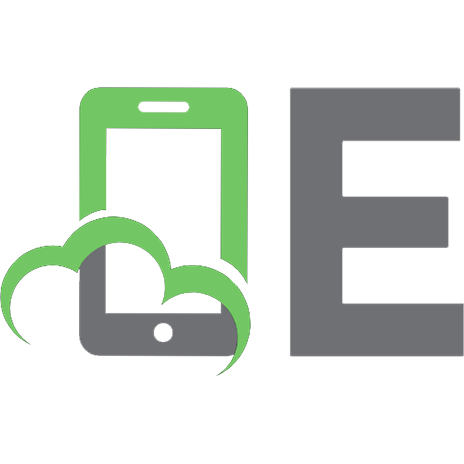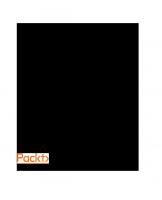Learn Kubernetes - Container orchestration using Docker
This book is for anyone who needs to run software on Kubernetes. Whether you’re a developer, a DevOps manager or a techn
151 22 2MB
English Pages 228 Year 2020
Table of contents :
Cover Page
Learn Kubernetes
Introduction
What this book is not
Prerequisites
How to read this book
Tools you need
Source code
1. Why Kubernetes
1.1 DevOps challenges
1.2 Containers
1.3 Docker containers
1.4 Deploying images
1.5 The need for container orchestration
1.6 What’s K8s?
2. Kubernetes cluster
2.1 Parts of a Kubernetes cluster
2.2 Creating a cluster
2.3 Exercise - Set up your development cluster
2.4 Exercise solution
2.5 Connecting to a cluster
3. Tooling
3.1 Kubernetes Dashboard
3.2 Visual Studio Code
3.3 Helm
4. Running pods
4.1 Deployments and ReplicaSets
4.2 Imperative commands
4.3 Exercise - Use imperative commands
4.4 Exercise solution
4.5 Exercise - Observe Kubernetes handle a failing pod
4.6 Exercise solution
4.7 Declarative commands
4.8 Exercise - Create resources using declarative commands
4.9 Exercise solution
4.10 Exercise - Update a Pod created declaratively
4.11 Exercise solution
4.12 Debugging
4.13 Exercise - Debugging failing Pods
4.14 Exercise solution
4.15 Exercise - Delete created objects
4.16 Exercise solution
4.17 Resources management
5. Exposing services
5.1 The need for services
5.2 Services
5.3 Exercise - Expose a web application to the internet
5.4 Exercise solution
5.5 Exercise - Expose an API inside the cluster
5.6 Exercise solution
5.7 Ingress
6. Volumes
6.1 The need for volumes
6.2 Short-lived storage with Volumes
6.3 Exercise - Create and use a Volume
6.4 Exercise solution
6.5 Persistent storage with PersistentVolumeClaims
6.6 Exercise - Create and use a PersistentVolume
6.7 Exercise solution
7. Configuration
7.1 Similar but different
7.2 ConfigMap
7.3 Exercise - Create and use a ConfigMap
7.4 Exercise solution
7.5 Secret
7.6 Exercise - Create and use a Secret
7.7 Exercise solution
8. Updating and scaling
8.1 Horizontal scaling
8.2 Automatic horizontal scaling
8.3 Update strategies
9. Sharing a cluster
9.1 Namespaces
9.2 RBAC
10. Helm
10.1 Using Helm
10.2 Creating Helm packages (charts)
A word from the author
Image attributions
The Learn collection
Cover Page
Learn Kubernetes
Introduction
What this book is not
Prerequisites
How to read this book
Tools you need
Source code
1. Why Kubernetes
1.1 DevOps challenges
1.2 Containers
1.3 Docker containers
1.4 Deploying images
1.5 The need for container orchestration
1.6 What’s K8s?
2. Kubernetes cluster
2.1 Parts of a Kubernetes cluster
2.2 Creating a cluster
2.3 Exercise - Set up your development cluster
2.4 Exercise solution
2.5 Connecting to a cluster
3. Tooling
3.1 Kubernetes Dashboard
3.2 Visual Studio Code
3.3 Helm
4. Running pods
4.1 Deployments and ReplicaSets
4.2 Imperative commands
4.3 Exercise - Use imperative commands
4.4 Exercise solution
4.5 Exercise - Observe Kubernetes handle a failing pod
4.6 Exercise solution
4.7 Declarative commands
4.8 Exercise - Create resources using declarative commands
4.9 Exercise solution
4.10 Exercise - Update a Pod created declaratively
4.11 Exercise solution
4.12 Debugging
4.13 Exercise - Debugging failing Pods
4.14 Exercise solution
4.15 Exercise - Delete created objects
4.16 Exercise solution
4.17 Resources management
5. Exposing services
5.1 The need for services
5.2 Services
5.3 Exercise - Expose a web application to the internet
5.4 Exercise solution
5.5 Exercise - Expose an API inside the cluster
5.6 Exercise solution
5.7 Ingress
6. Volumes
6.1 The need for volumes
6.2 Short-lived storage with Volumes
6.3 Exercise - Create and use a Volume
6.4 Exercise solution
6.5 Persistent storage with PersistentVolumeClaims
6.6 Exercise - Create and use a PersistentVolume
6.7 Exercise solution
7. Configuration
7.1 Similar but different
7.2 ConfigMap
7.3 Exercise - Create and use a ConfigMap
7.4 Exercise solution
7.5 Secret
7.6 Exercise - Create and use a Secret
7.7 Exercise solution
8. Updating and scaling
8.1 Horizontal scaling
8.2 Automatic horizontal scaling
8.3 Update strategies
9. Sharing a cluster
9.1 Namespaces
9.2 RBAC
10. Helm
10.1 Using Helm
10.2 Creating Helm packages (charts)
A word from the author
Image attributions
The Learn collection



![The Ultimate Docker Container Book: Build, test, ship, and run containers with Docker and Kubernetes [3 ed.]
9781804613986](https://ebin.pub/img/200x200/the-ultimate-docker-container-book-build-test-ship-and-run-containers-with-docker-and-kubernetes-3nbsped-9781804613986.jpg)
![Kubernetes Cookbook: Practical solutions to container orchestration [2 ed.]
9781788836876, 1788836871](https://ebin.pub/img/200x200/kubernetes-cookbook-practical-solutions-to-container-orchestration-2nbsped-9781788836876-1788836871.jpg)
![The Ultimate Docker Container Book: Build, test, ship, and run containers with Docker and Kubernetes [3rd ed.]
9781804613986, 1804613983](https://ebin.pub/img/200x200/the-ultimate-docker-container-book-build-test-ship-and-run-containers-with-docker-and-kubernetes-3rd-ed-9781804613986-1804613983.jpg)




